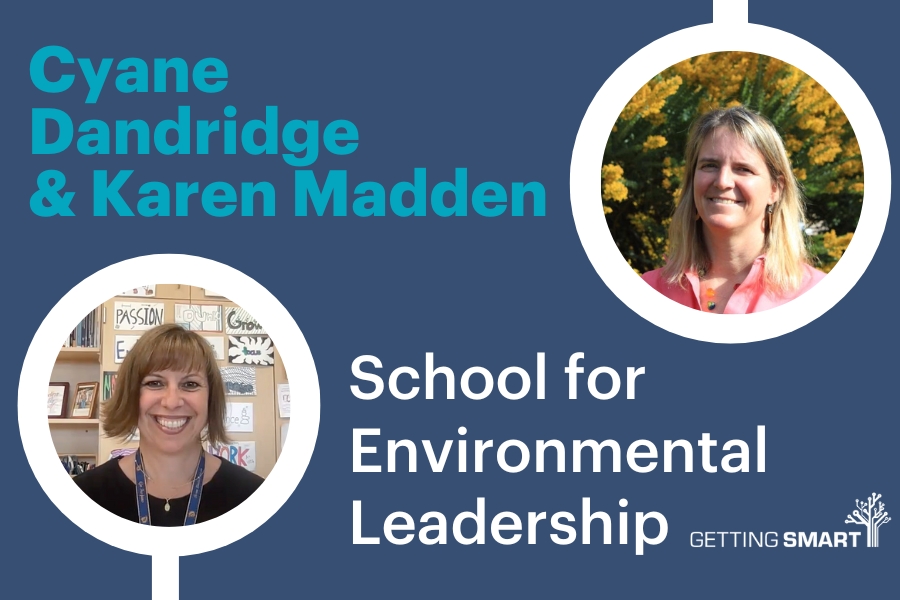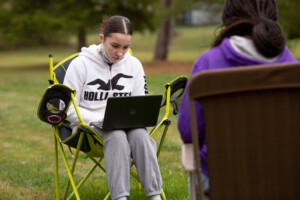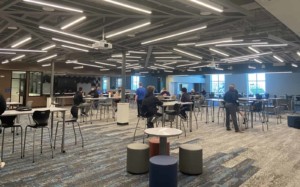Cyane Dandridge and Karen Madden on School for Environmental Leadership
Key Points
-
We must prepare students for problems that haven’t even been identified yet.

Are you interested in attending one of the field’s largest gatherings of K-12 education innovators? The Aurora Institute Symposium 2023 promises community, lessons about education innovation from the field, and the latest research and policy to support education transformation. Find out more here.
On this episode of the Getting Smart Podcast, Tom Vander Ark is joined by Cyane Dandridge, founder of SEI, an environmental nonprofit that builds leaders to drive sustainability solutions. One of those solutions is a high school model, School for Environmental Leadership (SEL). The flagship is MarinSEL, a “school within a school” located within Terra Linda High School in the San Rafael City Schools district and we’re excited to be also joined by Karen Madden, a teacher leader from MarinSEL.
Transcripts
Tom Vander Ark: Why should high school students learn environmental leadership?
Cyane Dandridge: Well, our world is facing some really incredible problems right now with climate change and so much at stake. I feel that we need to develop skills to address environmental issues and also to foster leadership skills, especially entrepreneurship. People going into their careers can then bring forward innovations in green technology and climate protection.
Tom Vander Ark: I’m Tom Vander Ark, and you’re listening to the Getting Smart podcast. Today, I’m joined by Cyane Dandridge, the founder of Strategic Energy Innovations (SEI), an environmental nonprofit in California. Among their sustainability solutions is a high school model called the School for Environmental Leadership (SEL). We’ll be discussing both SEI and SEL today. The flagship high school is in Marin County, a school-within-a-school model at Terra Linda High School in the San Rafael District, where Karen Madden is a teacher. Hi Karen, thanks for joining us. Are you at school today?
Karen Madden: Hi there, Tom. I am at school today, yes, and I’m wearing my Terra Linda High School shirt because we had an author event this morning. It’s been a great day.
Tom Vander Ark: Awesome! I’m really excited to learn more about the School for Environmental Leadership. But first, Cyane, how did you start on this path? I think it was about 30 years ago that you went to MIT to study sustainability—quite a bit before most people recognized its importance.
Cyane Dandridge: My undergraduate degree is in physics, and for my thesis, I looked at ways to adjust solar panels to more effectively capture energy and respond to different energy levels coming through our atmosphere. That experience highlighted a gap between renewable energy technology and people’s general understanding of it. So I went back to school to bridge that gap between research and the real-world application of technology.
Tom Vander Ark: And did you spend some time at the EPA in the early 1990s?
Cyane Dandridge: Yes, from around 1992 to 1999.
Tom Vander Ark: So what led you to start Strategic Energy Innovations?
Cyane Dandridge: Well, I learned that I’m not suited for a traditional government role. I saw the federal government doing great work on programs like Energy Star and big policy initiatives, but these efforts weren’t reaching the end user. I wanted to find ways to bridge that gap and ensure that policies translated to real action on the ground. That’s what SEI is about—providing resources and support to local communities so they can engage in climate protection and sustainability initiatives.
Tom Vander Ark: Was it about fourteen or fifteen years ago that you decided to create a high school academy around these themes?
Cyane Dandridge: Yes, we were already developing programs and curriculum to cultivate leaders who could tackle future environmental challenges. We’d been running high school programs for a while and working at different levels. I was even running green teams at my kids’ elementary school, and one of Karen Madden’s daughters was part of that. I noticed interest and engagement from young people, but there was a lack of comprehensive environmental programming at the high school level. As my own kids were nearing high school, I thought, “Why not start a high school?” So that’s what we did.
Tom Vander Ark: Karen, you’re the head teacher at the School for Environmental Leadership. Is it a four-year course of study?
Karen Madden: Yes, it is. Students apply as eighth graders and, if accepted, start in the ninth grade at Terra Linda High School. It’s a four-year program, with about 32 students per cohort. They travel through high school in this cohort, building on a sequence of courses. Freshmen have five classes with their cohort, and then, over the years, it reduces to three and then two classes by junior and senior year. The curriculum builds upon itself, focusing on creativity, communication, critical thinking, and collaboration. The students graduate with a wealth of skills to become leaders and problem solvers, prepared for real-world challenges.
Tom Vander Ark: Could you walk us through each of the four years? For instance, freshmen work on a “lead project.” What does that entail?
Karen Madden: Freshman year, students have a unique class called Environmental Leadership Seminar, where they work on semester-long lead projects—Leadership in Environmental Action and Design. In teams of five or six, they tackle community issues like wildfire safety, stormwater capture, or food waste diversion, under the guidance of a community mentor. It’s a messy process, but they learn to work together, facilitate meetings, take notes, and communicate effectively. At the end of each semester, they present their projects and measured results.
Sophomore year, they take on one lead project for the school year, focusing more deeply on policy change. Junior year is special—they take a sustainable enterprise class from the College of Marin, where each student creates a business plan and pitches it in a “shark tank” scenario. Selected projects then go into production, with students forming teams to bring their products to market. They also take an engineering class to learn how to use power tools.
Senior year includes another college-level class, along with a year-long sustainability-focused internship. They also compile a portfolio of their work, reflecting on what they’ve learned, how they could improve, and documenting their growth over the four years.
Tom Vander Ark: It sounds like a great sequence. Do students take math as part of this, or is that separate?
Karen Madden: Math, like foreign language and fine arts, is separate from the program. Students typically take math based on their level within the standard high school curriculum. Over the four years, however, some English, science, and social studies classes are part of the SEL cohort.
Tom Vander Ark: It sounds like a model that every high school could adopt, and arguably should adopt. Cyane, what’s your favorite part of this sequence, and why isn’t this kind of program in more high schools?
Cyane Dandridge: I wonder the same thing! I would love to see every high school in America adopt this model. I find it transformative. Personally, my favorite part is the business class in junior year. Watching students apply their skills, collaborate, and think critically, using design thinking to develop a product, is inspiring. During the shark tank presentations, industry experts are consistently impressed by the students’ performance, often saying that adults in similar programs don’t do as well.
Tom Vander Ark: Karen, have your own children gone through this program?
Karen Madden: Yes, both of our older daughters graduated from the program, and our son is currently enrolled. Our oldest daughter, now at Cal Poly, recently told my sophomore class that the skills she learned in SEL have been invaluable in college and internships. She shared how she drew on her presentation skills during a project at Boeing. That’s what I value most about this program—it provides students with experiences and skills that many high school students don’t get, preparing them to face future challenges with adaptability and confidence.
Tom Vander Ark: I love the focus on entrepreneurship and the idea that the climate crisis represents one of the biggest entrepreneurial opportunities of the next forty years. The electrification of everything, for example, will create huge business opportunities. Do you see these green opportunities as a big part of SEL’s mission?
Cyane Dandridge: Absolutely. With the federal government investing in climate initiatives and electrification, there’s a massive demand for skilled workers, especially electricians, to meet these needs. Programs like SEL encourage students to consider green careers and entrepreneurial opportunities, whether through two-year degrees, certifications, or launching eco-friendly businesses. They don’t necessarily need a four-year degree to make an impact and have a successful career.
Tom Vander Ark: You’re absolutely right. The ability to run an eco-friendly business and participate in the green economy is essential. This sounds like a valuable component of the SEL model. Cyane, SEI also has other initiatives beyond SEL, correct?
Cyane Dandridge: Yes, our mission at SEI is to build leaders who drive sustainability solutions. We work across education and workforce development, from kindergarten to career, to expose people to green career pathways. We have programs in college, like faculty learning communities that help integrate sustainability into curriculum. Our Climate Corps program places recent graduates in green careers across sectors, and our Energize Careers program supports individuals with barriers to employment, helping them pursue high-road green careers that offer a living wage and meaningful work.
Tom Vander Ark: That’s an impressive range. Karen, as the school year wraps up, what’s next for you and your students?
Karen Madden: This week, our freshmen just completed their lead presentations, which were incredible. They presented to a large audience, showcasing their projects and results. Next, they’ll reflect on their experience, completing self-assessments to consider what went well and how they can improve. For our juniors, an exciting project is coming up—they’re partnering with a local farm to build a shed and play structures for goats. It’s a chance to apply what they’ve learned in the classroom in a real-world setting. And finally, our seniors will soon present their senior symposium, where they reflect on their entire four years in the program, including their internship experiences. It’s a wonderful way to celebrate all they’ve achieved and to look forward to the next chapter, which, for this year’s class, includes commitments to four-year universities.
Tom Vander Ark: We’ve been talking to Karen Madden, lead teacher at the School for Environmental Leadership. Karen, where can people find out more about your environmental academy?
Karen Madden: You can find more information online at thesel.org. We’re the Marin School of Environmental Leadership, based at Terra Linda High School in San Rafael, Marin County, California.
Tom Vander Ark: Fantastic. And Cyane, as the founder of SEI, anything new or upcoming at SEI that you’d like to share before heading back to your work?
Cyane Dandridge: Absolutely, Tom. SEI is expanding, especially in the Pacific Northwest, the Northeast, and along the Eastern Seaboard. I’m particularly excited about our Climate Corps program, where we’ll be placing over 200 fellows across the country this year. These fellows will be engaging in impactful work within government, nonprofit, and for-profit organizations, all focused on advancing sustainability. It’s really rewarding to see this work grow and support meaningful, green career pathways.
Tom Vander Ark: That’s incredible. Where can people learn more about SEI?
Cyane Dandridge: They can visit our website at seiinc.org. It has all the information on our programs, our mission, and how we’re building leaders to drive sustainability solutions across the country.
Tom Vander Ark: We appreciate both of your contributions. I think you’ve gained some new fans here. We’ll be doing everything we can to encourage more schools to adopt the School for Environmental Leadership model. Karen and Cyane, thank you for joining us today. And thanks to Mason Pasha, our producer, and the entire Getting Smart team for making this episode possible. Until next week, keep learning, keep leading, and keep innovating for equity.
Karen Madden: Thank you, Tom.
Cyane Dandridge: Thank you, Tom. It’s been a pleasure.
Tom Vander Ark: And let’s add sustainability to that. Think about sustainability this week, everyone. See you next week.
Links:








0 Comments
Leave a Comment
Your email address will not be published. All fields are required.